The Role of Non-Representational Hand Gestures in Creative Thinking
Abstract
1. Introduction
2. Gestures’ Role in Cognition
2.1. The Role and Cognitive Functions of Beat and Palm-Revealing Gestures
2.2. The Role of Gestures in Creative Thinking
2.3. The Role of Mental Imagery in Gestures and Creative Thinking
2.4. The Present Study
3. Experiment 1
- 1.
- Encouraged beat gestures will be helpful for divergent thinking, irrespective of mental imagery skills, as beat gestures have been proposed to be less imagistic, and divergent thinking was not related to mental imagery in previous studies (see Hyusein & Göksun, 2024).
- 2.
- Both spontaneous and encouraged palm-revealing gestures will be negatively associated with divergent thinking because they serve interactive functions.
3.1. Method
3.1.1. Participants
3.1.2. Materials
Divergent Thinking Assessment
Mental Imagery Assessment
3.1.3. Procedure and Study Design
3.1.4. Coding and Scoring Procedures
Alternative Uses Test (AUT) Scoring
Gesture Coding
3.2. Results
3.2.1. Differences in Non-Representational Gesture Frequency Across Groups and Conditions
3.2.2. Beat Gestures in Group 1 (Gesture-Spontaneous and Gesture-Encouraged Conditions)
3.2.3. Beat Gestures in Group 1 and Group 2 (Gesture-Encouraged Conditions)
3.2.4. Palm-Revealing Gestures in Group 1 (Gesture-Spontaneous and Gesture-Encouraged Conditions)
3.2.5. Palm-Revealing Gestures in Group 1 and Group 2 (Gesture-Encouraged Conditions)
3.3. Discussion
4. Experiment 2
- Spontaneous beat and palm-revealing gestures will be negatively associated with divergent thinking, as shown in Experiment 1.
- Spontaneous beat and palm-revealing gestures will not be associated with convergent thinking (based on Hyusein and Göksun’s (2023) findings).
- Higher mental imagery vividness might negatively impact the relationship between spontaneous beat and palm-revealing gestures and convergent thinking (based on Hyusein & Göksun, 2025).
4.1. Method
4.1.1. Participants
4.1.2. Materials
4.1.3. Coding Procedure
4.2. Results
4.2.1. Beat Gestures During Divergent Thinking
4.2.2. Beat Gestures During Convergent Thinking
4.2.3. Palm-Revealing Gestures During Divergent Thinking
4.2.4. Palm-Revealing Gestures During Convergent Thinking
4.3. Discussion
5. General Discussion
5.1. Beat Gestures
5.2. Palm-Revealing Gestures
5.3. Theoretical Implications and Future Directions
6. Conclusions
Supplementary Materials
Author Contributions
Funding
Institutional Review Board Statement
Informed Consent Statement
Data Availability Statement
Acknowledgments
Conflicts of Interest
References
- Arslan, B., & Göksun, T. (2020). Ageing, working memory, and mental imagery: Understanding gestural communication in younger and older adults. Quarterly Journal of Experimental Psychology, 74(1), 29–44. [Google Scholar] [CrossRef]
- Aydin, C., Göksun, T., Otenen, E., Tanis, S. B., & Şentürk, Y. D. (2023). The role of gestures in autobiographical memory. PLoS ONE, 18(2), e0281748. [Google Scholar] [CrossRef]
- Biau, E., Fromont, L. A., & Soto-Faraco, S. (2018). Beat gestures and syntactic parsing: An ERP study. Language Learning, 68(Suppl. S1), 102–126. [Google Scholar] [CrossRef]
- Bosker, H. R., & Peeters, D. (2021). Beat gestures influence which speech sounds you hear. Proceedings of the Royal Society B Biological Sciences, 288(1943), 20202419. [Google Scholar] [CrossRef]
- Chu, M., & Kita, S. (2011). The nature of gestures’ beneficial role in spatial problem solving. Journal of Experimental Psychology: General, 140(1), 102–116. [Google Scholar] [CrossRef]
- Chu, M., Meyer, A. S., Foulkes, L., & Kita, S. (2014). Individual differences in frequency and saliency of speech-accompanying gestures: The role of cognitive abilities and empathy. Journal of Experimental Psychology: General, 143(2), 694–709. [Google Scholar] [CrossRef]
- Cienki, A., & Mittelberg, I. (2013). 11. Creativity in the forms and functions of spontaneous gestures with speech. In De Gruyter eBooks (pp. 231–252). [Google Scholar] [CrossRef]
- Clark, H. H., & Fox Tree, J. E. (2002). Using uh and um in spontaneous speaking. Cognition, 84(1), 73–111. [Google Scholar] [CrossRef]
- Clough, S., & Duff, M. C. (2020). The role of gesture in communication and cognition: Implications for understanding and treating neurogenic communication disorders. Frontiers in Human Neuroscience, 14, 323. [Google Scholar] [CrossRef] [PubMed]
- Cook, S. W., Yip, T. K., & Goldin-Meadow, S. (2011). Gestures, but not meaningless movements, lighten working memory load when explaining math. Language and Cognitive Processes, 27(4), 594–610. [Google Scholar] [CrossRef] [PubMed]
- Cooperrider, K., Abner, N., & Goldin-Meadow, S. (2018). The palm-up puzzle: Meanings and origins of a widespread form in gesture and sign. Frontiers in Communication, 3, 23. [Google Scholar] [CrossRef]
- Çapan, D., Furman, R., Göksun, T., & Eskenazi, T. (2023). Hands of confidence: When gestures increase confidence in spatial problem-solving. Quarterly Journal of Experimental Psychology, 77(2), 257–277. [Google Scholar] [CrossRef] [PubMed]
- Dimitrova, D., Chu, M., Wang, L., Özyürek, A., & Hagoort, P. (2016). Beat that Word: How listeners integrate beat gesture and focus in multimodal speech discourse. Journal of Cognitive Neuroscience, 28(9), 1255–1269. [Google Scholar] [CrossRef] [PubMed]
- Di Nuovo, S., Castellano, S., & Guarnera, M. A. (2014). Mental imagery test. Hogrefe. [Google Scholar]
- Donoff, C. M. (2019). Measuring mental imagery [Master’s thesis, University of Alberta]. [Google Scholar]
- Ferrari, A., & Hagoort, P. (2024). Beat gestures and prosodic prominence interactively influence language comprehension. Cognition, 256, 106049. [Google Scholar] [CrossRef] [PubMed]
- Feyereisen, P., & Havard, I. (1999). Mental imagery and production of hand gestures while speaking in younger and older adults. Journal of Nonverbal Behavior, 23(2), 153–171. [Google Scholar] [CrossRef]
- Finke, R. A., Ward, T. B., & Smith, S. M. (1992). Creative cognition: Theory, research, and applications. A Bradford Book. [Google Scholar]
- Freedman, N., van Meel, J. M., Barroso, F., & Bucci, W. (1986). On the development of communicative competence. Semiotica, 62(1–2), 77–106. [Google Scholar] [CrossRef]
- George, T., & Wiley, J. (2020). Need something different? Here’s what’s been done: Effects of examples and task instructions on creative idea generation. Memory & Cognition, 48(2), 226–243. [Google Scholar] [CrossRef]
- Goldin-Meadow, S., & Beilock, S. L. (2010). Action’s influence on thought: The case of gesture. Perspectives on Psychological Science, 5(6), 664–674. [Google Scholar] [CrossRef]
- Guilford, J. P. (1967). The nature of human intelligence (1st ed.). McGraw-Hill. [Google Scholar]
- Güneş Acar, N., Göksun, T., & Tekcan, A. İ. (2024). Details in hand: How does gesturing relate to autobiographical memory? Language, Cognition and Neuroscience, 39(10), 1310–1324. [Google Scholar] [CrossRef]
- Holle, H., Obermeier, C., Schmidt-Kassow, M., Friederici, A. D., Ward, J., & Gunter, T. C. (2012). Gesture facilitates the syntactic analysis of speech. Frontiers in Psychology, 3, 74. [Google Scholar] [CrossRef]
- Hostetter, A. B., & Alibali, M. W. (2007). Raise your hand if you’re spatial. Gesture, 7(1), 73–95. [Google Scholar] [CrossRef]
- Hostetter, A. B., & Alibali, M. W. (2019). Gesture as simulated action: Revisiting the framework. Psychonomic Bulletin & Review, 26, 721–752. [Google Scholar] [CrossRef]
- Hyusein, G., & Göksun, T. (2023). The creative interplay between hand gestures, convergent thinking, and mental imagery. PLoS ONE, 18(4), e0283859. [Google Scholar] [CrossRef] [PubMed]
- Hyusein, G., & Göksun, T. (2024). Give your ideas a hand: The role of iconic hand gestures in enhancing divergent creative thinking. Psychological Research. [Google Scholar] [CrossRef]
- Hyusein, G., & Göksun, T. (2025). Thinking creatively in two languages: Effects of mental imagery vividness, foreign language proficiency and hand gestures on bilingual creativity. Bilingualism Language and Cognition, 1–16. [Google Scholar] [CrossRef]
- Kendon, A. (2004). Gesture visible action as utterance. Cambridge University Press. [Google Scholar] [CrossRef]
- Khatin-Zadeh, O., Farsani, D., & Reali, F. (2022). A Study of using metaphoric and beat gestures with motion-based and non-motion-based metaphors during retelling stories. Behavioral Sciences, 12(5), 129. [Google Scholar] [CrossRef] [PubMed]
- Kim, J. (2015). Physical activity benefits creativity: Squeezing a ball for enhancing creativity. Creativity Research Journal, 27(4), 328–333. [Google Scholar] [CrossRef]
- Kirk, E., & Lewis, C. (2017). Gesture facilitates children’s creative thinking. Psychological Science, 28(2), 225–232. [Google Scholar] [CrossRef]
- Kita, S., Alibali, M. W., & Chu, M. (2017). How do gestures influence thinking and speaking? The gesture-for-conceptualization hypothesis. Psychological Review, 124(3), 245–266. [Google Scholar] [CrossRef]
- Kısa, Y. D., Goldin-Meadow, S., & Casasanto, D. (2024). Gesturing during disfluent speech: A pragmatic account. Cognition, 250, 105855. [Google Scholar] [CrossRef]
- Koriat, A., Ma’ayan, H., & Nussinson, R. (2006). The intricate relationships between monitoring and control in metacognition: Lessons for the cause-and-effect relation between subjective experience and behavior. Journal of Experimental Psychology: General, 135(1), 36–69. [Google Scholar] [CrossRef]
- Krauss, R. M., Dushay, R. A., Chen, Y., & Rauscher, F. (1995). The communicative value of conversational hand gestures. Journal of Experimental Social Psychology, 31(6), 533–552. [Google Scholar] [CrossRef]
- Laurent, A., Smithson, L., & Nicoladis, E. (2020). Gesturers tell a story creatively; non-gesturers tell it like it happened. Language Learning and Development, 16(3), 292–308. [Google Scholar] [CrossRef]
- Lebuda, I., & Benedek, M. (2023). A systematic framework of creative metacognition. Physics of Life Reviews, 46, 161–181. [Google Scholar] [CrossRef]
- Lebuda, I., & Benedek, M. (2024). Contributions of metacognition to creative performance and behavior. The Journal of Creative Behavior, 59, e652. [Google Scholar] [CrossRef]
- Lewis, C., Lovatt, P., & Kirk, E. (2015). Many hands make light work: The facilitative role of gesture in verbal improvisation. Thinking Skills and Creativity, 17, 149–157. [Google Scholar] [CrossRef]
- Liao, J., & Wang, H. C. (2019). Gestures as Intrinsic Creativity Support. Proceedings of the ACM on Human-Computer Interaction, 3(GROUP), 1–16. [Google Scholar] [CrossRef]
- Lucero, C., Zaharchuk, H., & Casasanto, D. (2014). Beat gestures facilitate speech production. Cognitive Science, 36(36), 898–903. Available online: https://escholarship.org/content/qt8pw1x0sx/qt8pw1x0sx.pdf?t=op9xps (accessed on 12 August 2025).
- Marrese, O. H., Raymond, C. W., Fox, B. A., Ford, C. E., & Pielke, M. (2021). The grammar of obviousness: The palm-up gesture in argument sequences. Frontiers in Communication, 6, 663067. [Google Scholar] [CrossRef]
- Marschark, M., West, S. A., Nall, L., & Everhart, V. (1986). Development of creative language devices in signed and oral production. Journal of Experimental Child Psychology, 41(3), 534–550. [Google Scholar] [CrossRef] [PubMed]
- McAvinue, L. P., & Robertson, I. H. (2007). Measuring Visual Imagery Ability: A Review. Imagination, Cognition and Personality, 26(3), 191–211. [Google Scholar] [CrossRef]
- McClave, E. (1994). Gestural beats: The rhythm hypothesis. Journal of Psycholinguistic Research, 23(1), 45–66. [Google Scholar] [CrossRef]
- McNeill, D. (1992). Hand and mind: What gestures reveal about thought. University of Chicago Press. [Google Scholar]
- Mednick, S. (1962). The associative basis of the creative process. Psychological Review, 69(3), 220–232. [Google Scholar] [CrossRef]
- Moulton, S. T., & Kosslyn, S. M. (2009). Imagining predictions: Mental imagery as mental emulation. Philosophical Transactions of the Royal Society of London. Series B, Biological Sciences, 364(1521), 1273–1280. [Google Scholar] [CrossRef]
- Müller, C. (2004). Forms and uses of the Palm Up Open Hand: A case of a gesture family? In C. Müller, & R. Posner (Eds.), The semantics and pragmatics of everyday gestures (pp. 233–256). Weidler. [Google Scholar]
- Müller, C. (2014). Gestural modes of representation as techniques of depiction. In Body–language–communication: An international handbook on multimodality in human interaction (Vol. 2, pp. 1687–1702). De Gruyter. [Google Scholar] [CrossRef]
- Novack, M. A., & Goldin-Meadow, S. (2017). Gesture as representational action: A paper about function. Psychonomic Bulletin & Review, 24(3), 652–665. [Google Scholar] [CrossRef]
- Ongchoco, J. D. K., & Scholl, B. J. (2021). Scaffolded attention in time: ‘Everyday hallucinations’ of rhythmic patterns from regular auditory beats. Attention Perception & Psychophysics, 84(2), 332–340. [Google Scholar] [CrossRef]
- Palermo, L., Iaria, G., & Guariglia, C. (2008). Mental imagery skills and topographical orientation in humans: A correlation study. Behavioural Brain Research, 192(2), 248–253. [Google Scholar] [CrossRef] [PubMed]
- Pang, H. T., Zhou, X., & Chu, M. (2024). Cross-cultural differences in using nonverbal behaviors to identify indirect replies. Journal of Nonverbal Behavior, 48(2), 323–344. [Google Scholar] [CrossRef]
- Payrató, L., & Teßendorf, S. (2014). Pragmatic gestures. In Body–language–communication: An international handbook on multimodality in human interaction (Vol. 2, pp. 1531–1539). De Gruyter. [Google Scholar]
- Prieto, P., Cravotta, A., Kushch, O., Rohrer, P., & Vilà-Giménez, I. (2018). Deconstructing beat gestures: A labelling proposal. Speech Prosody, 201–205. [Google Scholar] [CrossRef]
- Rademaker, R. L., & Pearson, J. (2012). Training visual imagery: Improvements of metacognition, but not imagery strength. Frontiers in Psychology, 3, 224. [Google Scholar] [CrossRef]
- R Core Team. (2013). R: A language and environment for statistical computing. R Core Team. [Google Scholar]
- Rohrer, P. L., Delais-Roussarie, E., & Prieto, P. (2020). Beat Gestures for Comprehension and Recall: Differential effects of language learners and native listeners. Frontiers in Psychology, 11, 575929. [Google Scholar] [CrossRef]
- Rominger, C., Fink, A., Weber, B., Papousek, I., & Schwerdtfeger, A. R. (2020). Everyday bodily movement is associated with creativity independently from active positive affect: A Bayesian mediation analysis approach. Scientific Reports, 10(1), 11985. [Google Scholar] [CrossRef]
- Runco, M. A., & Jaeger, G. J. (2012). The standard definition of creativity. Creativity Research Journal, 24(1), 92–96. [Google Scholar] [CrossRef]
- Salvi, C., & Bowden, E. M. (2016). Looking for creativity: Where do we look when we look for new ideas? Frontiers in Psychology, 7, 161. [Google Scholar] [CrossRef]
- Shepard, R. N., & Metzler, J. (1971). Mental rotation of three-dimensional objects. Science, 171(3972), 701–703. [Google Scholar] [CrossRef]
- Slepian, M. L., & Ambady, N. (2012). Fluid movement and creativity. Journal of Experimental Psychology: General, 141(4), 625–629. [Google Scholar] [CrossRef]
- So, W. C., Kita, S., & Goldin-Meadow, S. (2009). Using the hands to identify who does what to whom: Gesture and speech go Hand-in-Hand. Cognitive Science, 33(1), 115–125. [Google Scholar] [CrossRef] [PubMed]
- So, W. C., Sim Chen-Hui, C., & Low Wei-Shan, J. (2011). Mnemonic effect of iconic gesture and beat gesture in adults and children: Is meaning in gesture important for memory recall? Language and Cognitive Processes, 27(5), 665–681. [Google Scholar] [CrossRef]
- Thomas, L. E., & Lleras, A. (2009). Swinging into thought: Directed movement guides insight in problem solving. Psychonomic Bulletin & Review, 16(4), 719–723. [Google Scholar] [CrossRef] [PubMed]
- Türk, O., & Calhoun, S. (2023). Phrasal synchronization of gesture with prosody and information structure. Language and Speech, 67(3), 702–743. [Google Scholar] [CrossRef]
- Vilà-Giménez, I., & Prieto, P. (2018). Encouraging children to produce rhythmic beat gestures leads to better narrative discourse performances. Speech Prosody, 704–708. [Google Scholar] [CrossRef]
- Vilà-Giménez, I., & Prieto, P. (2020). Encouraging kids to beat: Children’s beat gesture production boosts their narrative performance. Developmental Science, 23(6), e12967. [Google Scholar] [CrossRef]
- Wang, L., & Chu, M. (2013). The role of beat gesture and pitch accent in semantic processing: An ERP study. Neuropsychologia, 51(13), 2847–2855. [Google Scholar] [CrossRef]
- Yap, D., Brookshire, G., & Casasanto, D. (2018). Beat gestures encode spatial semantics. Cognitive Science. Available online: https://cognitivesciencesociety.org/wp-content/uploads/2019/01/cogsci18_proceedings.pdf (accessed on 12 August 2025).
- Yılmaz, B., Furman, R., Göksun, T., & Eskenazi, T. (2025). Speech disfluencies and hand gestures as metacognitive cues. Cognitive Science, 49(8), e70093. [Google Scholar] [CrossRef]
- Zabelina, D., Saporta, A., & Beeman, M. (2016). Flexible or leaky attention in creative people? Distinct patterns of attention for different types of creative thinking. Memory & Cognition, 44(3), 488–498. [Google Scholar] [CrossRef]
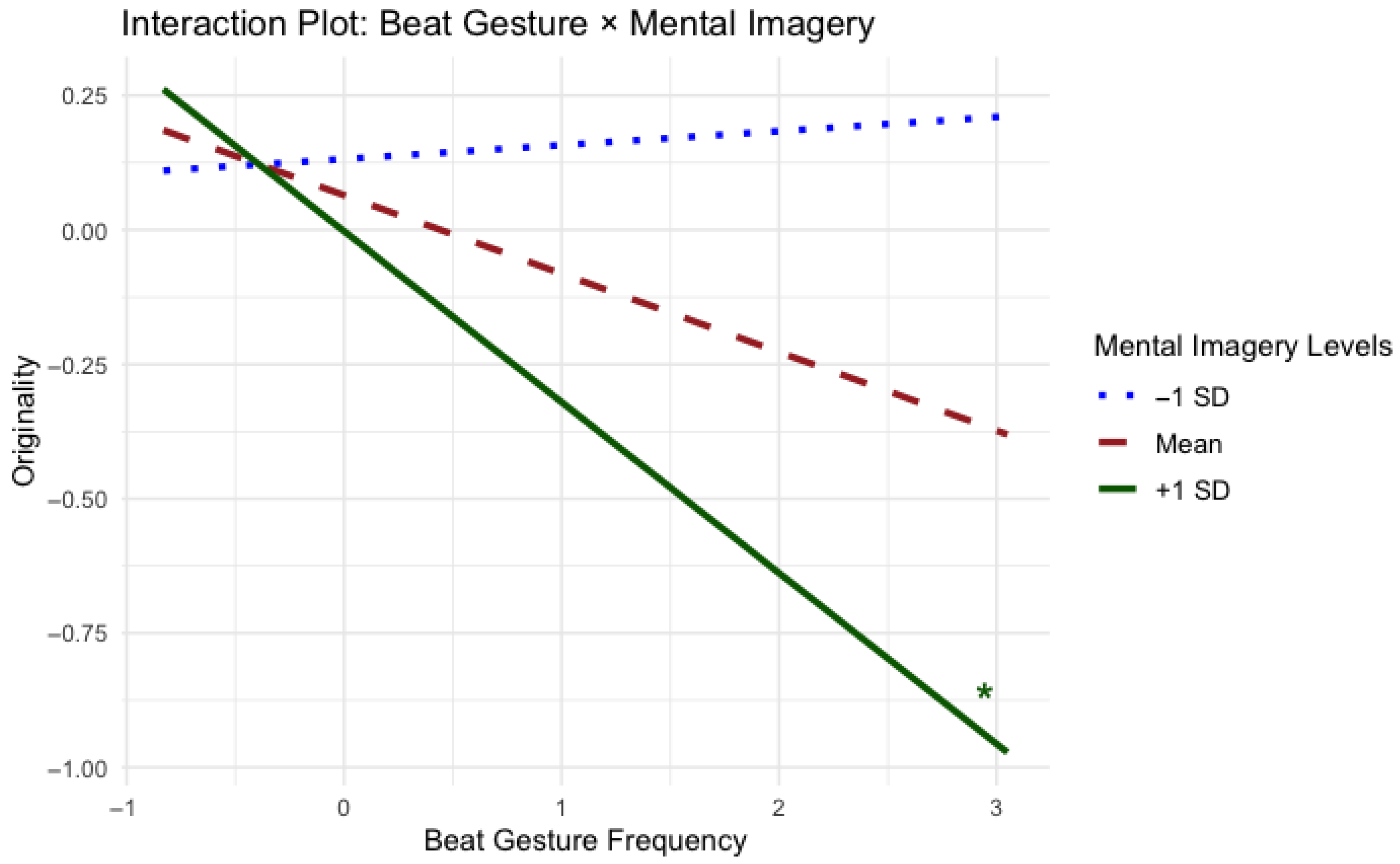
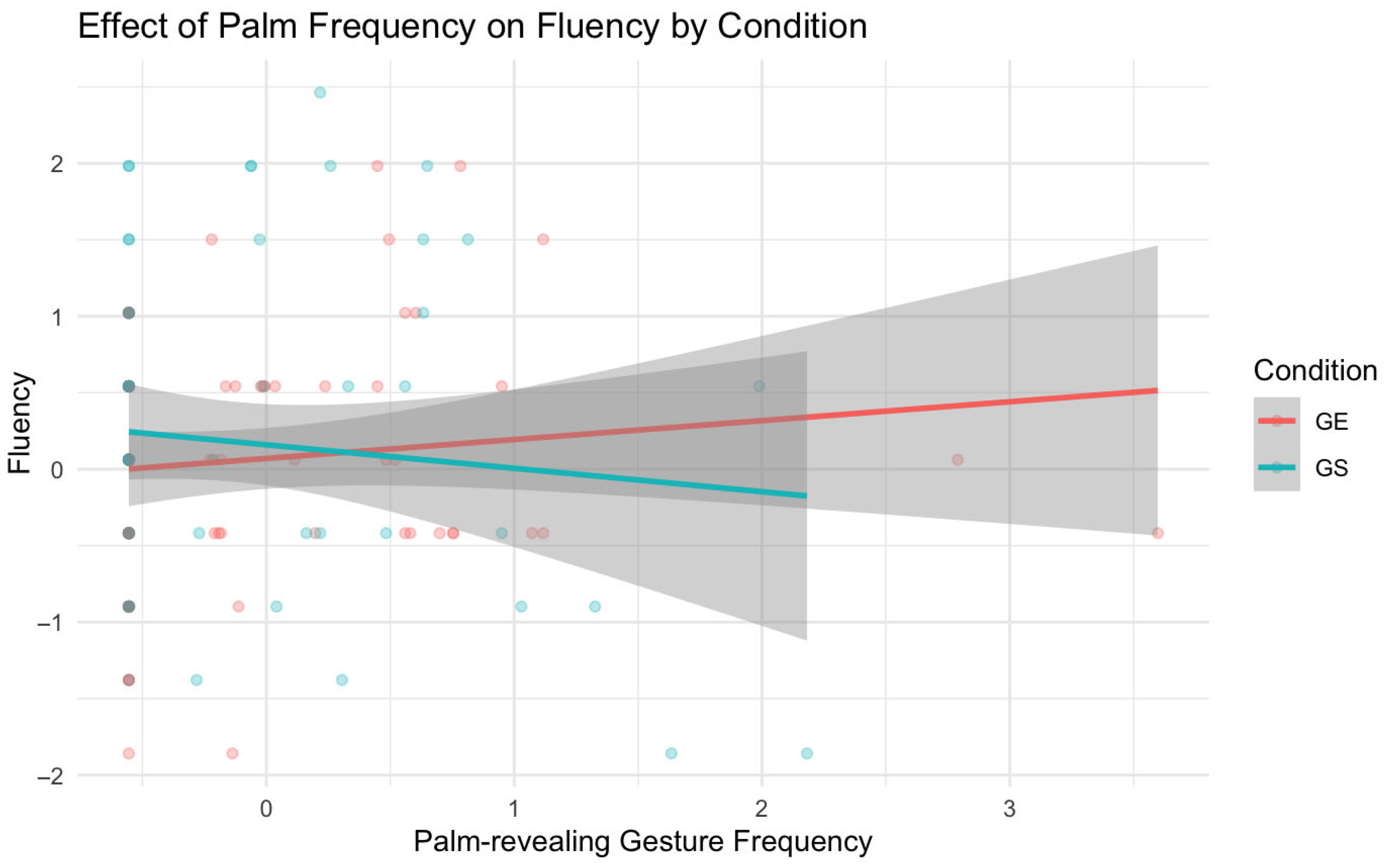
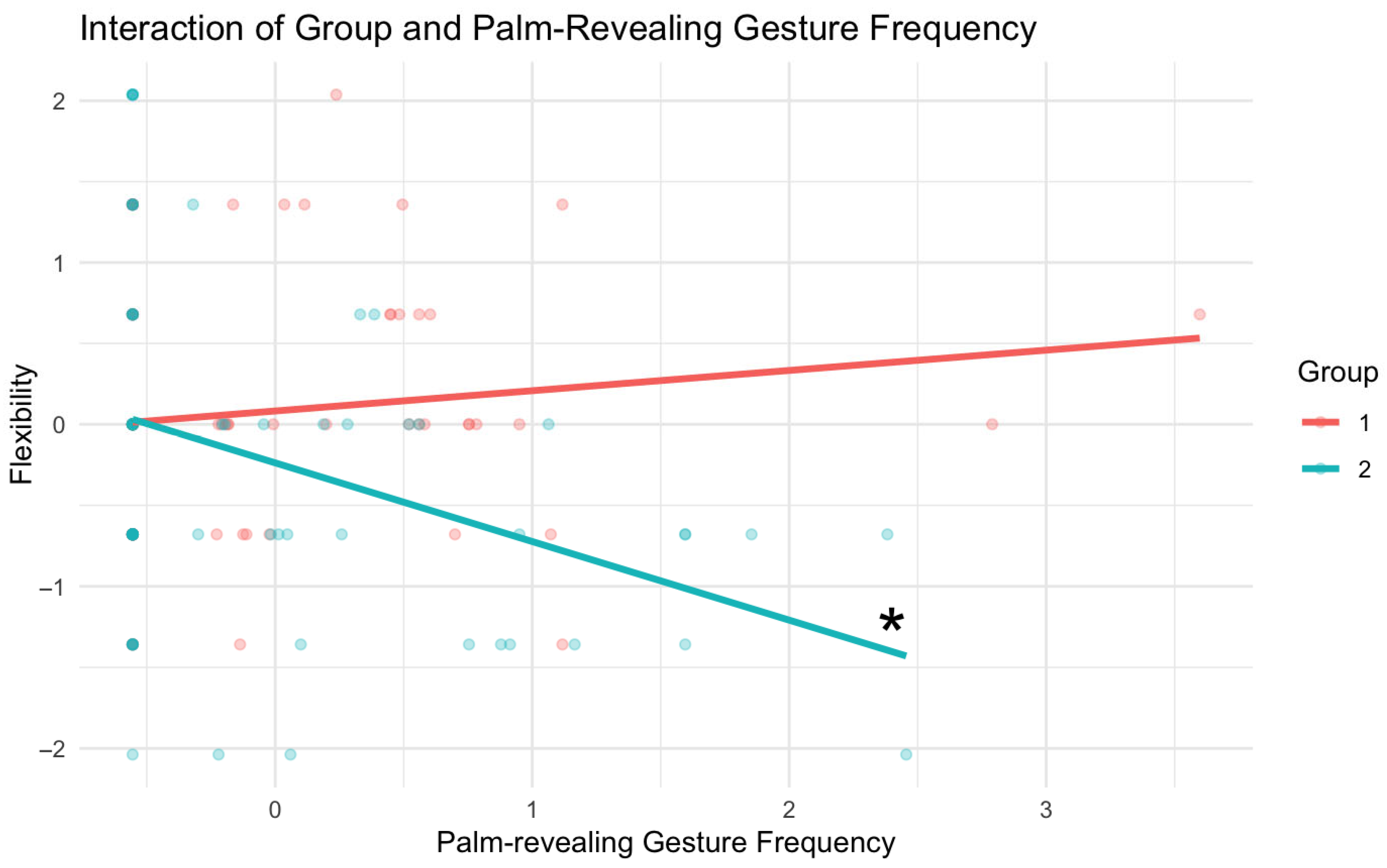
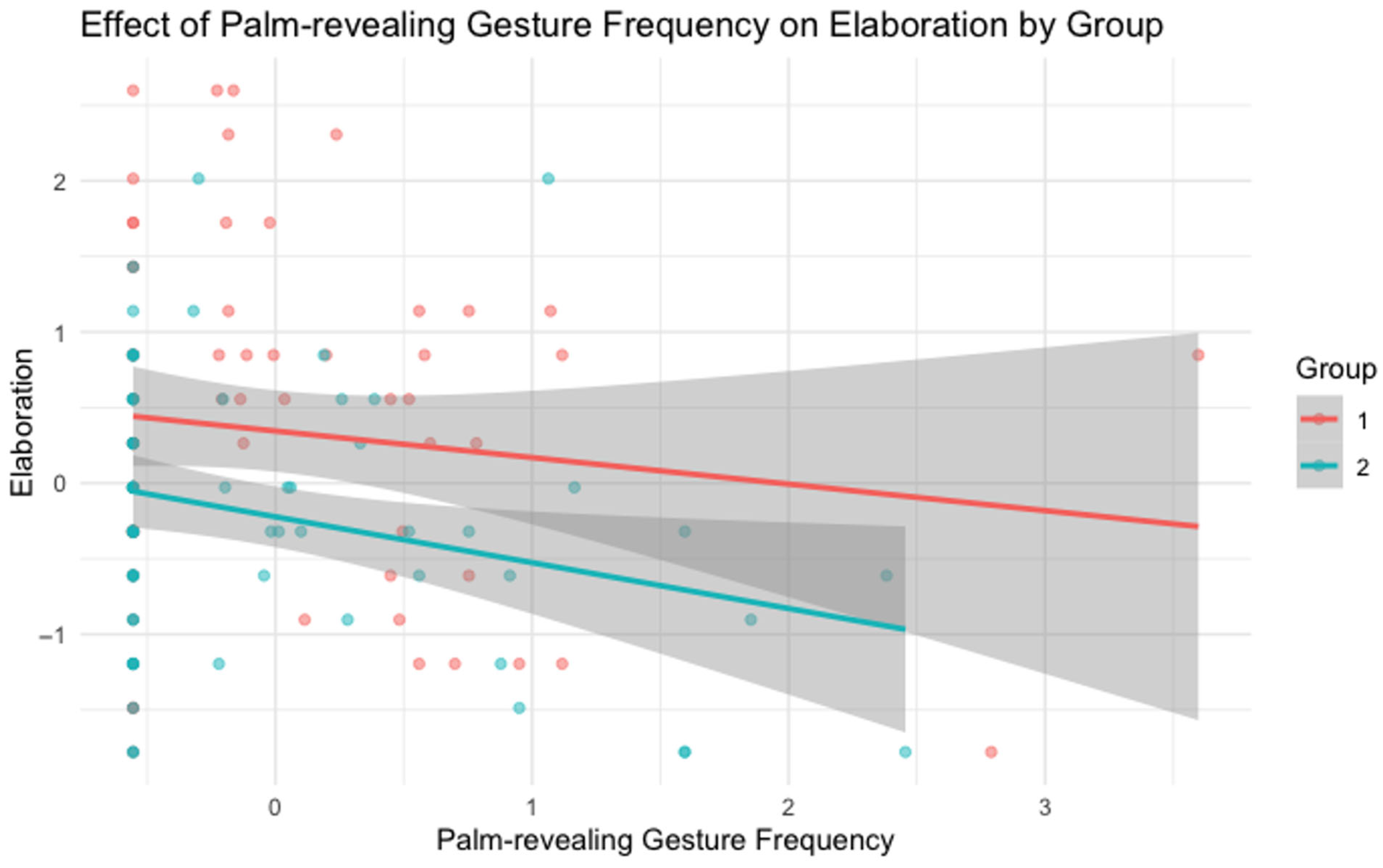
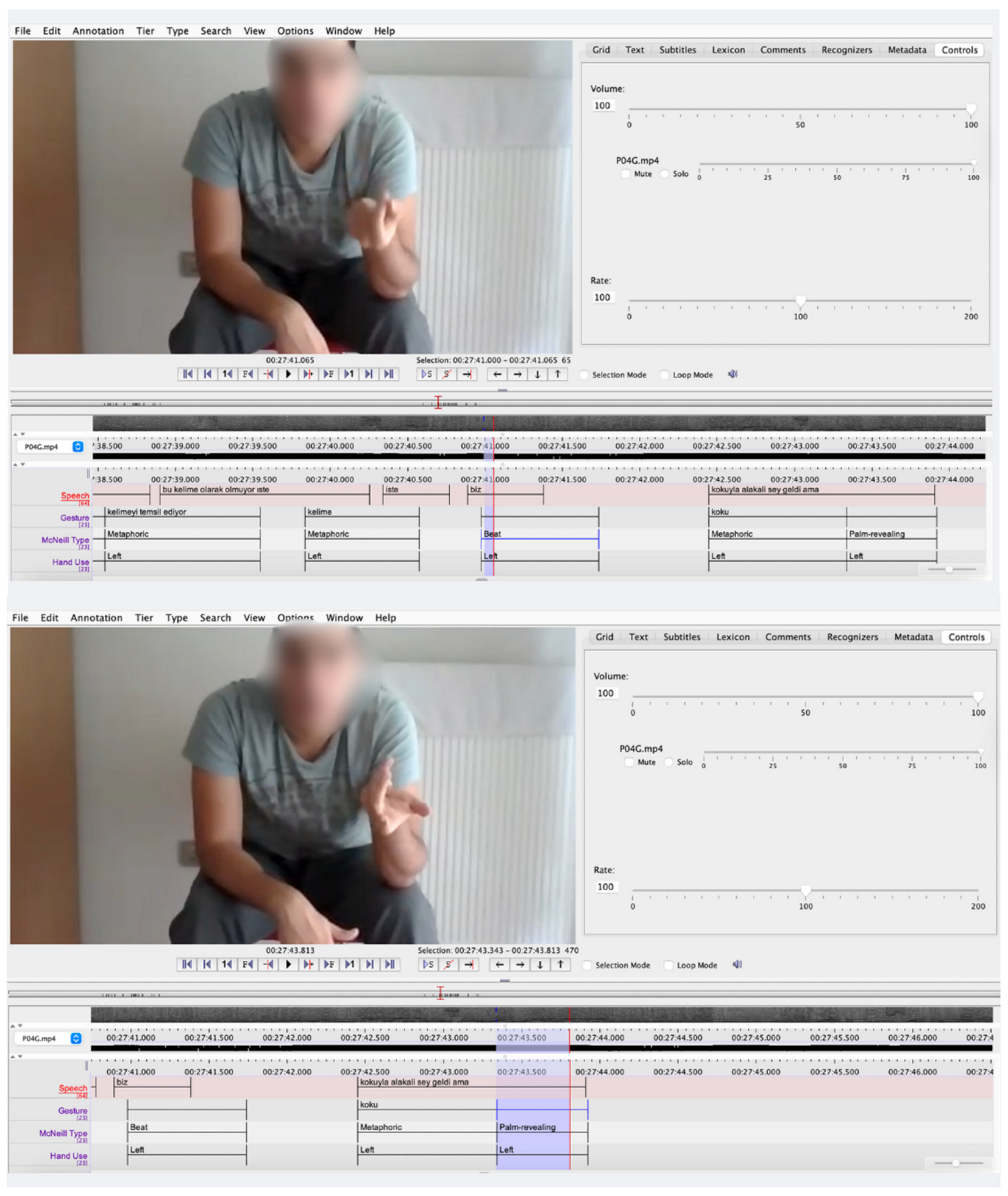

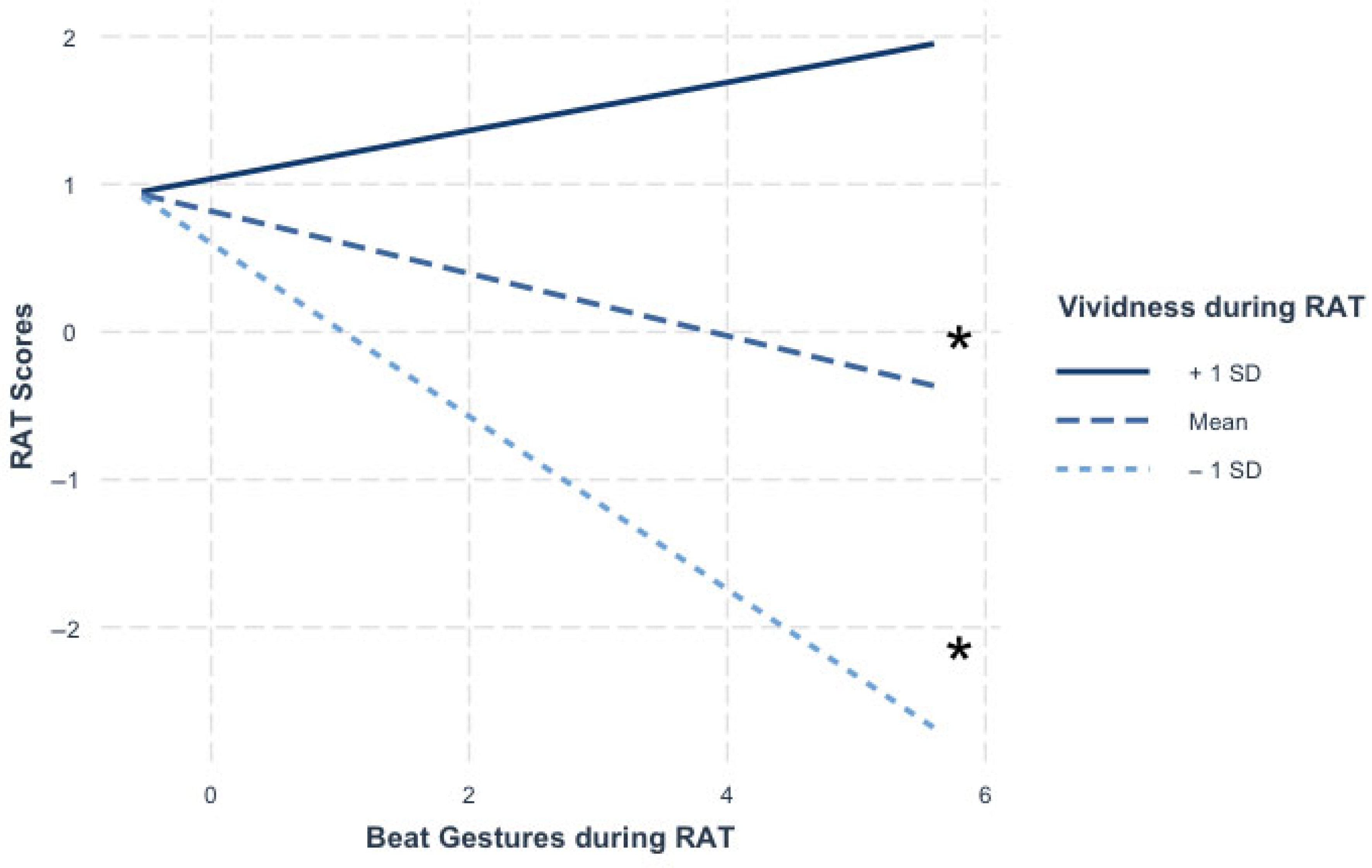
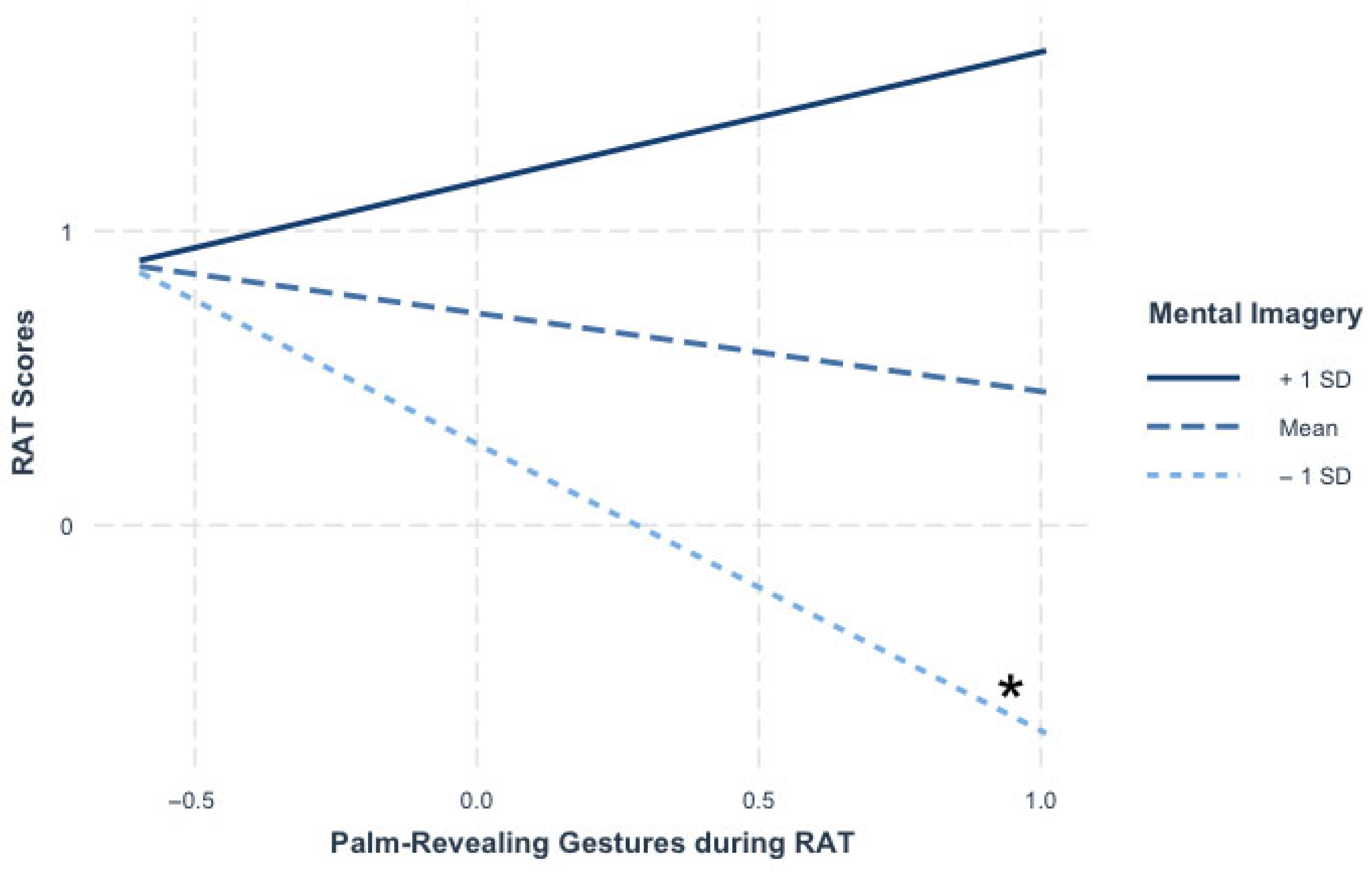
| Group | ||||||
|---|---|---|---|---|---|---|
| Gesture-Spontaneous Group 1 (GS1) | Gesture-Encouraged Group 1 (GE1) | Gesture-Encouraged Group 2 (GE2) | ||||
| M | SD | M | SD | M | SD | |
| AUT Fluency | 6.09 | 2.12 | 5.90 | 1.81 | 5.63 | 2.29 |
| AUT Originality | 2.48 | 1.97 | 2.49 | 1.94 | 2.44 | 2.33 |
| AUT Flexibility | 4.31 | 1.56 | 4.06 | 1.24 | 3.63 | 1.53 |
| AUT Elaboration | 5.94 | 3.14 | 7.09 | 3.77 | 5.26 | 3.13 |
| Beat Gesture Frequency | 0.04 | 0.05 | 0.05 | 0.05 | 0.05 | 0.06 |
| Palm-revealing Gesture Frequency | 0.01 | 0.02 | 0.02 | 0.03 | 0.02 | 0.05 |
| Mental Imagery Score | 69.42 | 7.32 | 69.42 | 7.32 | 68.83 | 7.58 |
| M | SD | Min. | Max. | |
|---|---|---|---|---|
| AUT Score | 71.7 | 27.2 | 24 | 127 |
| RAT Score | 6.4 | 1.7 | 2 | 10 |
| AUT Vividness | 70.9 | 20.1 | 31 | 100 |
| RAT Vividness | 55.0 | 20.1 | 12.6 | 94.5 |
| AUT Beat Gesture Frequency | 0.05 | 0.04 | 0 | 0.18 |
| RAT Beat Gesture Frequency | 0.03 | 0.05 | 0 | 0.25 |
| AUT Palm-revealing Gesture Frequency | 0.01 | 0.01 | 0 | 0.05 |
| RAT Palm-revealing Gesture Frequency | 0.03 | 0.04 | 0 | 0.17 |
| Mental Imagery Score | 71.9 | 7.03 | 54 | 83 |
Disclaimer/Publisher’s Note: The statements, opinions and data contained in all publications are solely those of the individual author(s) and contributor(s) and not of MDPI and/or the editor(s). MDPI and/or the editor(s) disclaim responsibility for any injury to people or property resulting from any ideas, methods, instructions or products referred to in the content. |
© 2025 by the authors. Licensee MDPI, Basel, Switzerland. This article is an open access article distributed under the terms and conditions of the Creative Commons Attribution (CC BY) license (https://creativecommons.org/licenses/by/4.0/).
Share and Cite
Hyusein, G.; Göksun, T. The Role of Non-Representational Hand Gestures in Creative Thinking. Languages 2025, 10, 206. https://doi.org/10.3390/languages10090206
Hyusein G, Göksun T. The Role of Non-Representational Hand Gestures in Creative Thinking. Languages. 2025; 10(9):206. https://doi.org/10.3390/languages10090206
Chicago/Turabian StyleHyusein, Gyulten, and Tilbe Göksun. 2025. "The Role of Non-Representational Hand Gestures in Creative Thinking" Languages 10, no. 9: 206. https://doi.org/10.3390/languages10090206
APA StyleHyusein, G., & Göksun, T. (2025). The Role of Non-Representational Hand Gestures in Creative Thinking. Languages, 10(9), 206. https://doi.org/10.3390/languages10090206






